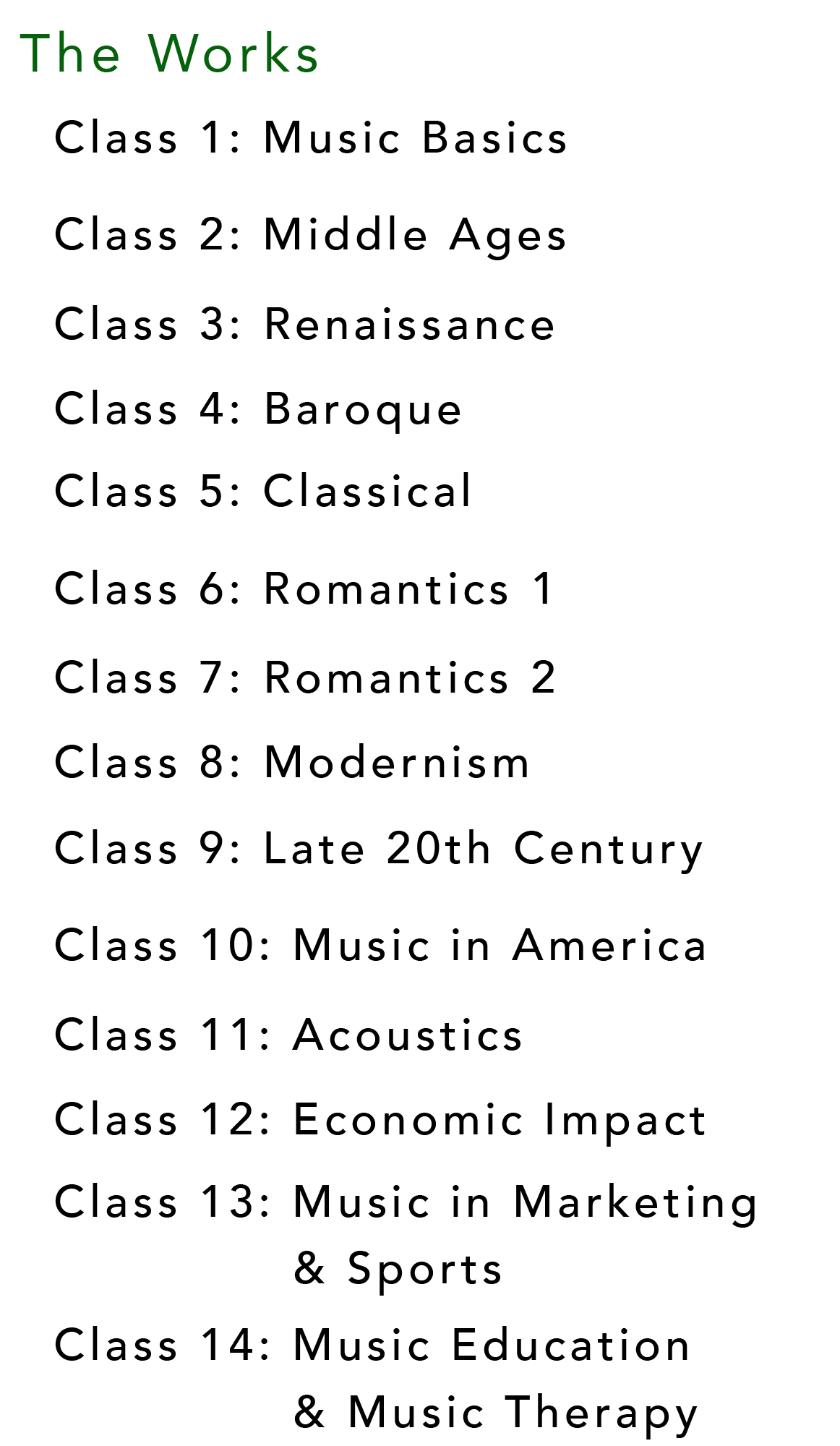Next session begins February 15th. ENROLL NOW
The Works
Music Basics
All the basic music theory you need so you can follow along with our lectures when we look through written music. Notes, rests, rhythms, clefs, and meters – it’s all there. Don’t worry, it’s really much easier than it sounds.
Middle Ages (300–1400)
Today’s music had to start somewhere. The Middle Ages is where we find the origins of written music.
Renaissance (14th-16th Centuries)
Considered a “rebirth” for humanity, this era saw an explosion of advancements in all aspects of life – think Columbus, Magellan, da Vinci, and Shakespeare. The era also ushered in the beginnings of standard practices in music that are still used when writing today’s major hits, including rap and ska.
Baroque (1600-1750)
Another tremendous growth period, particularly in terms of patronage and opulence. Royals used the arts to show-off their wealth and power, which led to the creation of a pivotal genre in music – opera! Other highlights from the Baroque include the writings of Johann Sebastian Bach and the holiday favorite “Hallelujah!” chorus from Handel’s Messiah.
Classical (1750-1820)
While being one of the shorter periods in music, this era still saw incredible contributions to the music we
hear in the concert halls. The great masters like “Papa” Haydn, Mozart, and Beethoven helped define the rules for composing that would go on to shape music for the next two centuries.
Romantics (Part 1) (early 1800’s-Pre WWI)
This is when we see the orchestra grow in size and scope. Composers began telling stories through their
music like never before, and humankind and music alike saw unprecedented development through various social and political revolutions.
Romantics (Part 2)
That's right, Part 2! Given the breadth of changes in both music and society, TWO classes are needed
to cover all the developments in both society and art that were ushered in during the Romantic Era.
Modernism (First half of the 20thCentury)
Art reflects life, which was evident by the effects two world wars had on people’s perspective on the world
around them. Just as war would spill over man-made borders, artists began looking to expand beyond the long-held rules and limitations of their own craft.
The Late 20th Century (1940’s-early 2000’s)
After World War II, society and composers alike found themselves grasping for a handle on the moment. This uncertainty led to a variety of new artistic genres, societal norms, and a direct challenge to the very definition of “music”. This would yield a jump over the edge into the avant garde (yup, all the weird notes-mixed-with-non-notes and the “bleep-blop-bloops”). But never fear – the Postmodernists are here! They brought us back to tonality just in time to put a big shiny bow on the second millennium.
Music in America
From music of the colonies to jazz, blues to Broadway, we explore music in the New
World and see how a convergence of cultures created the music that would define the very essence of the United States. The music that came out of America’s melting pot would go on to have the greatest
impact on worldwide culture and solidify the U.S. as the new music industry leader, even before the
country saw its 200th birthday.
Acoustics
The science of sound. We look at how music moves – or doesn’t – around us. Like how front row seats may be the most expensive in the house, but that doesn’t always mean they’re the best. In fact, they’re usually the worst (hint: It’s the cheapies you want to snag!).
Economic Impact
The fine and performing arts contribute almost $1 trillion to the U.S. economy ANNUALLY!! That’s more than agriculture, more than construction, way more than sports could ever dream of – and that number grows every year [there isn’t a pandemic]. We look at how the government’s investment in the arts sees a return of over 5,000% annually (yes, three zeroes).
Music in Marketing & Music and Sports
Part A: Music in Marketing
Everywhere you look and in every facet of our society, you’ll find art and music. Since the invention of the radio, music has been the most vital aspect of marketing and advertising. Nowadays, no industry can survive without the arts!
Part B: Music and Sports
We compare the economic and logistical impacts of the arts to that of the sports industry – arguably the arts’ biggest competition for entertainment dollars and municipal support. We’ll answer the question of “Why is it more important to build a new theatre in town instead of a new football stadium?”.
Music Education, Participation, and Therapy
Part A: Education and Participation
Unfortunately, simply listening to classical music does not increase a child’s intelligence (i.e. “the Mozart Effect” = old wives’ tale). However, countless studies have shown that when a child participates in music, they have a better understanding of the world around them and perform much better in school and on cognitive tests. Now what parent wouldn’t want to learn more about that??
Part B: Music Therapy
We all have those particular songs we go to when we’re feeling happy, sad, angry, unmotivated, excited – or when we’re not feeling those ways but want to be. In addition to being the second most powerful memory trigger we have (smells are #1), music has proven to have amazing “healing” powers when used to address the physical, emotional, cognitive, and social needs of individuals.

